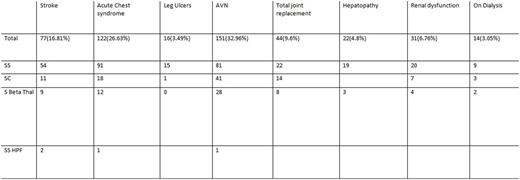Abstract
Introduction: Sickle cell disease can lead to variety of complications like strokes, acute chest syndrome (ACS), sickle cell hepatopathy, priapism, renal dysfunction, avascular necrosis (AVN) ofjoints , pulmonary hypertension and leg ulcers. Average life expectancy of patient with SCD has improved with better treatments available. Most of literature on SCD in form pediatric literature and data on adults is considerably lacking. We did a retrospective analysis to investigate the prevalence of complications in adult patients with SCD.
Methods: We take care of around 300 adult active patients with SCD at our hematology clinic. We did a retrospective analysis from 458 adult patients seen at our clinic between 2001 and 2016. We collected data on gender, race, type of SCD, complications like stroke, acute chest syndrome, iron overload, leg ulcers, AVN, hepatopathy and renal dysfunction.
Results: A total of 458 adult patients with SCD were analyzed. 231 were female and 227 were males. The total number of patients with SC disease was 114, SS was 263, sickle beta thal was 75 and 4 had SS with hereditary persistence of Hemoglobin F (SS HPF). The number patient with complication has been listed in table below.
Conclusion: Adult Centers for the treatment of Sickle Cell Disease need to optimize care directed at these high frequency, life changing and life shortening complications. Multidisciplinary care teams have to focus on these chronic complications that include transfusion program, iron overload treatment and prevention, orthopedic care and Hepatitis C and B directed carealong with acute complication care. This retrospective study serves as the basis for our adult Sickle Cell Disease program at Louisiana State University Health Science Center in Shreveport, Louisiana.
No relevant conflicts of interest to declare.
Author notes
Asterisk with author names denotes non-ASH members.


This feature is available to Subscribers Only
Sign In or Create an Account Close Modal